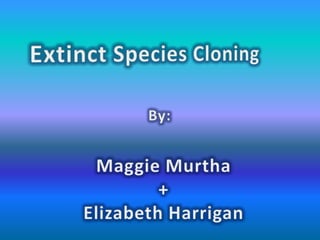
Extinct species cloning elizabeth &maggie2.pptx h
- 1. Extinct Species Cloning By: Maggie Murtha + Elizabeth Harrigan
- 2. Basic Principles of Genetics The recessive allele is masked when the dominant allele is present. Co dominance is a condition in which neither of the two alleles of a gene is dominant or recessive. A Punnett Square is a chart that shows all the possible combinations of alleles that can result from a Genetic Cross. Geneticists use Punnett Squares to show all the possible outcomes of a genetic cross and to determine probability of a particular outcome.
- 3. Human Genome Project A genome is all the DNA in one cell of an organism . The Project begin approximately around the 1900’s. Scientist will know the DNA sequence of every human gene, and the amino acid sequence of protein. It was speculated that this project would take two decades. Some scientist did not even think it could be done because the technology was not ready for this kind of project. ELSI focused on dealing with the most immediate applications or consequences of genome research. These issues involve genetics research, responsible clinical integration of new genetic technologies, privacy and fair use of genetic information, and professional and public education about these issues.
- 4. Genetic Disorder Years ago, doctors had only Punnett Squares and pedigrees to help them predict whether a child might have a genetic disorder Today doctors use tools such as amniocentesis and karyotypes to help detect genetic disorders Genetic Disorder is an abnormal condition that a person inherits through genes or chromosomes. Genetic Disorders are caused by mutations or changes in a persons DNA.
- 6. Argument 1 I am for Extinct Species Cloning because it is used for a good cause. Another reason why I am for Extinct Species Cloning is because if there are any animals that are extinct we can clone them so that they can come back and we can have more of them in our world today.
- 7. Argument 2 I am for Extinct Species cloning because animals a lot of the mammals that were on Earth years ago are no longer on Earth and with Extinct Animal Species Cloning , we will be able to have them back on Earth.
- 8. Argument 3 I am against animal cloning because if cloning does come out, it is going to cost a fortune with our economy. If the company or industry that comes out with cloning, how are they going to get people to purchase their product when it costs so much. The below poverty level citizens won’t be able to get cloned because they can’t afford it. So either they lower the price of cloning or no one is going to buy it. Also, what if cloning gets in the hands of the wrong people like Adolph Hitler. They could do what ever they want like clone bad people of the past. One of the biggest arguments about cloning today is bad cloning. Is it Hollywood fantasy or possible reality? An example of cloning gone bad is used in the 1993 hit movie Jurassic Park. In this movie, it is proved that you can clone the bodies of dinosaurs and bring them back to life. But, the dinosaurs turn monstrous. This is one bad example of cloning.
- 9. Argument 4 Another bad example of cloning is the famous, Dolly the sheep. She was cloned and now her clone is weak and is suffering. She was the first animal clone made ever by scientists. The technique that led to Dolly is called somatic cell nuclear transfer and has remained essentially unchanged over the decade. A mammalian egg is taken, and its nucleus - the DNA programming for making life - is removed. After this breakthrough, other mammals started to become cloned but became weak.
- 10. Conclusion While doing this project, Maggie and I learned a lot of new information on The Basic Principles of Genetics, Human Genome Project and The Basic Principles of Genetics. Some information that we learned is that
- 11. Works Cited Text book pages In the Chapter 4 section. http://campus.udayton.edu/~hume/Genome/genome.htm www.ornl.gov/hgmis/home.shtml "Cloning Extinct Animals." Extinct Animal. Web. 25 Mar. 2011. <http://extinctanimal.com/cloning.htm>. Ingham, By Richard. "Hello, Dolly: The Sheep That Changed the World | COSMOS Magazine." COSMOS Magazine | The Science of Everything. Web. 25 Mar. 2011. <http://www.cosmosmagazine.com/news/392/hello-dolly-the-sheep-changed-world>. "The Human Genome Project." Untitled Document. Web. 25 Mar. 2011. <http://campus.udayton.edu/~hume/Genome/genome.htm>. "Cloning Extinct Animals." Extinct Animal. Web. 25 Mar. 2011. <http://extinctanimal.com/cloning.htm>.